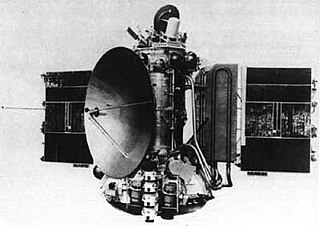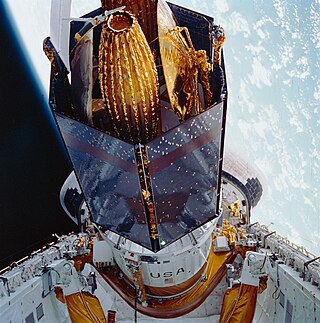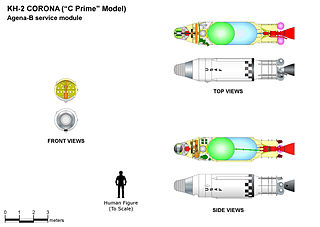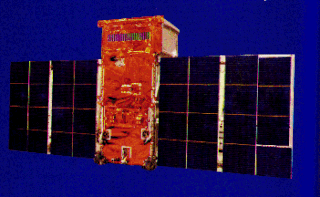
Mars 4, also known as 3MS No.52S was a Soviet spacecraft intended to explore Mars. A 3MS spacecraft launched as part of the Mars programme, it was intended to enter orbit around Mars in 1974. However, computer problems prevented orbital insertion from occurring.

European Remote Sensing satellite (ERS) was the European Space Agency's first Earth-observing satellite programme using a polar orbit. It consisted of two satellites, ERS-1 and ERS-2, with ERS-1 being launched in 1991.
The Space Test Program (STP) is the primary provider of spaceflight for the United States Department of Defense (DoD) space science and technology community. STP is managed by a group within the Advanced Systems and Development Directorate, a directorate of the Space and Missile Systems Center of the United States Space Force. STP provides spaceflight via the International Space Station (ISS), piggybacks, secondary payloads and dedicated launch services.

Orbiting Vehicle or OV, originally designated SATAR, comprised five disparate series of standardized American satellites operated by the US Air Force, launched between 1965 and 1971. Forty seven satellites were built, of which forty three were launched and thirty seven reached orbit. With the exception of the OV3 series and OV4-3, they were launched as secondary payloads, using excess space on other missions. This resulted in extremely low launch costs and short proposal-to-orbit times. Typically, OV satellites carried scientific and/or technological experiments, 184 being successfully orbited through the lifespan of the program.

TDRS-3, known before launch as TDRS-C, is an American communications satellite, of first generation, which is operated by NASA as part of the Tracking and Data Relay Satellite System. It was constructed by TRW, and is based on a custom satellite bus which was used for all seven first generation TDRS satellites.
Lewis was an American satellite which was to have been operated by NASA as part of the Small Satellite Technology Initiative. It carried two experimental Earth imaging instruments, and an ultraviolet astronomy payload. Due to a design flaw it failed within three days of reaching orbit, before it became operational.

Discoverer 17, also known as Corona 9012, was an American optical reconnaissance satellite launched on 12 November 1960 at 20:38:00 GMT. It was the second of ten Corona KH-2 satellites, based on the Agena-B.

Discoverer 18, also known as Corona 9013, was an American optical reconnaissance satellite launched on 7 December 1960 at 20:24:00 GMT. It was the first successful, and the third of ten total Corona KH-2 satellites, based on the Agena-B.
Hermes was an American satellite which was to have been operated by the Colorado Space Grant Consortium. Intended to perform technology demonstration experiments in low Earth orbit, it was lost during launch in March 2011 when the rocket that was carrying it failed to achieve orbit.

TD-1A, or Thor-Delta 1A, was a European astrophysical research satellite which was launched in 1972. Operated by the European Space Research Organisation, TD-1A made astronomical surveys primarily in the ultraviolet, but also using x-ray and gamma ray detectors.

BioSentinel is a lowcost CubeSat spacecraft on a astrobiology mission that will use budding yeast to detect, measure, and compare the impact of deep space radiation on DNA repair over long time beyond low Earth orbit.
Vela 4A was an American reconnaissance satellite to detect explosions and nuclear tests on land and in space. It was released together with Vela 4B, ERS 18, OV5 1 and OV5 3.
Vela 4B was an American reconnaissance satellite to detect explosions and nuclear tests on land and in space. It was released together with Vela 4A, ERS 18, OV5 1 and OV5 3.

Orbiting Vehicle 1-1, was the first satellite in the OV1 series of the United States Air Force's Orbiting Vehicle program. OV1-1 was an American Earth science research satellite designed to measure radiation, micrometeoroid density, and magnetic fields in orbit. Launched 21 January 1965, the mission resulted in failure when, after a successful launch of its Atlas booster, OV1-1's onboard Altair motor failed to fire.

Orbiting Vehicle 1-2, launched 5 October 1965, was the third, and first successful, satellite in the OV1 series of the United States Air Force's Orbiting Vehicle program. A radiation measuring satellite designed to conduct research for the planned Manned Orbital Laboratory project, OV1-2 was the first American spacecraft to be placed into orbit on a western trajectory. The satellite stopped functioning in April 1967 after a series of technical problems starting two months after launch.

Orbiting Vehicle 2-3, the second satellite of the second series of the United States Air Force's Orbiting Vehicle program, was an American solar astronomy, geomagnetic and particle science research satellite. Launched 22 December 1965 along with three other satellites, the mission resulted in failure when the spacecraft failed to separate from the upper stage of its Titan IIIC.

Orbiting Vehicle 2-5, the third and last satellite of the second series of the United States Air Force's Orbiting Vehicle program, was an American particle science and ionosphere research satellite. Launched 26 September 1968 along with three other satellites, OV2-5 became the first scientific satellite to operate at geosynchronous altitude.

Orbiting Vehicle 5-1, was an X-ray measuring microsatellite launched in support of the United States Air Force's space weather prediction program. Launched on 28 April 1967, it was the first satellite in the OV5 series of the United States Air Force's Orbiting Vehicle program. Data was collected until November 1967, and the satellite turned itself off in June 1967. OV5-1 is still in orbit as of 11 February 2023.

Orbiting Vehicle 5-3, was a materials science microsatellite launched on 28 April 1967 and still in orbit as of 2020. Carrying a variety of metal and plastic samples, it conducted friction tests on them in the vacuum of space to help determine their usability in space equipment. OV5-3 was the second satellite in the OV5 series of the United States Air Force's Orbiting Vehicle program.

Orbiting Vehicle 5-8, was a materials science microsatellite launched, along with 12 other satellites in the biggest multi-satellite launch to date, on 18 August 1968 on the first Atlas Burner 2 rocket. The rocket and all payloads were lost when the second stage (Burner) shroud collapsed after first stage (Atlas) cutoff. OV5-8 was the third satellite in the OV5 series of the United States Air Force's Orbiting Vehicle program.
















